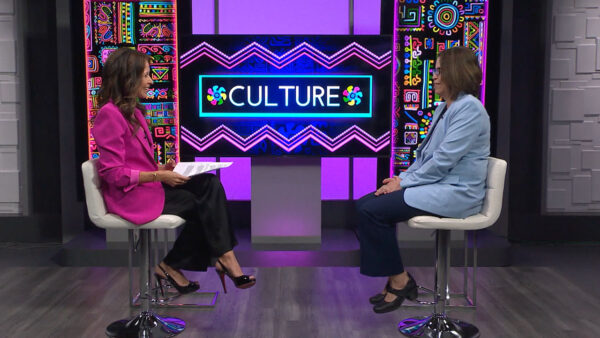The Heard Museum presents an exhibition called Latino Folk Tales: Cuentos Populares -Art By Latino Artists featuring original illustrations from 12 award-winning children’s book artists. Dr. Ann Marshall, Heard Museum director of curation and education, and Kathy Cano-Murillo, artist and exhibit participant, talk about the exhibition.
José Cárdenas: In tonight's Sounds of Cultura SOC, the Heard Museum will present an exhibition featuring original illustrations from 12 award-winning children's book artists. The exhibition is called "Latino Folk Tales Cuentos Populares, Art by Latino Artists". Here with me to talk about the exhibit is Dr. Ann Marshall, Director of Curation and Education at the Heard Museum. Also, here is Kathy Cano-Murillo, Artist and one of the exhibit participants. Thank you both for joining us on "Horizonte." Dr. Marshall, let's begin by talking about how this exhibition came to be.
Dr. Ann Marshall: Well, you know, every year we do a Spanish market in November. It's just two days and we were really looking for an exhibit to have something that would extend the wonderful artists that are out there and so when this came to our attention, "Cuentos Populares" it's a family activity. It has wonderful stories and the art is just -- it's so engaging. You just -- you look at the art and you want to know the story.
José Cárdenas: And this is an exhibition that was put together and has toured several cities already.
Dr. Ann Marshall: New Jersey, it's been in Texas, Arizona, New Mexico.
José Cárdenas: And when are we going to see it?
Dr. Ann Marshall: Well, it's opening Saturday.
José Cárdenas: And for how long is it available?
Dr. Ann Marshall: Until January 5th. So we have it through the first of the year.
José Cárdenas: And the special magic of this exhibition as I understand it is you'll have these what 12 pieces of art that will be on display?
Dr. Ann Marshall: There are about 60 paintings.
José Cárdenas: 60 paintings from these books.
Dr. Ann Marshall: Yes.
José Cárdenas: And it's both the paintings from the books, and then you have people like Kathy on some of these sessions reading the books themselves.
Dr. Ann Marshall: They're reading the books. We have reading areas in the gallery, too. So we'll have the books there. When there's not a formal program going on, people can just sit down and read the story behind the art on the wall.
José Cárdenas: Kathy, you're a fairly well known artist here in Arizona. What's your sense of the exhibition and why are you involved?
Kathy Cano-Murillo: Oh, gosh well, there's so many different layers involved with why I'm inspired by it. First of all, my husband and I have been artists at Spanish market for many years and we love the way that it really elevates Latino culture and art and I love with this exhibit combining children's books and the illustrations on an artistic level and showing the actual original paintings from the book, I mean that's going to be amazing for the children to see and for someone like myself who, you know, has always dreamed of being an artist and a painter to think of little girls or boys, who can go see this exhibit see these paintings and maybe start their career early and say, you know, what I love this book and here's the actual painting from the book, I want to try painting, too, or I want to author a children's book, or share a story as well.
José Cárdenas: Let's talk about the book you're going to be reading. We don't have one of the pictures from this book but this is the one that you're going to be reading.
Kathy Cano-Murillo: On November 16th, I'll be reading "The First Tortilla" by Rudolfo Anaya and the artwork the artist is Amy Córdova. I'm a fan girl of her art. I love her paintings. They're so multilayered and very vibrant, colorful, empowering, positive and not just for children's books but also for women and people of all cultures and backgrounds.
José Cárdenas: You'll be reading the book, of course, but how will you expand on that experience?
Kathy Cano-Murillo: Well, for one thing I'm a blogger and I definitely will be blogging about the experience beforehand to let people know to come out to see the exhibit, giving my personal excitement about it to share that and then once I'm there, I want to meet the people who are going to be there listening to my reading and expose them to the other artists whose work will also be there. There's so many benefits from it that I'm looking forward to and just being inspired by the art and the writing, all of it combined, I think it's such a treat for families of all generations and cultures to come see and get inspired.
José Cárdenas: We've got some pictures from four of the books that we're going to put up on the screen but the first one is from "Golden Tales" and we have a picture from that one. Tell us, first of all, about the book, and then we'll put the picture on the screen.
Dr. Ann Marshall: That's an example now of an artist who is also the author. And she created stories around some of the Native-American legends. And so in this case we have a wonderful story.
José Cárdenas: We've got the picture on the screen there.
Dr. Ann Marshall: Of the first Inca. Manco Cápac and The rod of gold. And he's going to find the place where that rod of gold can be thrust into the ground. And that place turned out to be the founding of the Cusco.
José Cárdenas: And then we have next up, "Fiesta Femenina." It's another book that will be read and discussed. We've got some wonderful pictures. There's the first one.
Dr. Ann Marshall: The artist here is Maya Gonzalez. And that particular figure Malen Sin, it tells the story of how she came to be so much a part of this mountain after so much tragedy.
José Cárdenas: The story we're talking about Malen Sin, is the Indian name for the woman how came to be known as la malinche, who has kind of a mixed history or at least perspective in Mexican history, the benedict Arnold of Mexico. She served as Cortés' traitor. She's portrayed differently in this book. When I say Cortés' traitor I mean translator.
Dr. Ann Marshall: In this book, she's so saddened by the horror that Cortes inflicts upon her people that she weeps and weeps until a river forms, and she flows away and the wind takes her to a mountain where she joins with some pretty powerful gods and together, they watch over the people and every now, and then they send some destruction and some correction to help her people. So she becomes a part of that mountain.
José Cárdenas: Before we go to the next book, Kathy, how important is it for little girls in particular to hear stories like this about very important historical figures, female historical figures?
Kathy Cano-Murillo: I think it's important, one thing with these books, first of all, it's very difficult to have a children's book published. Being an author I've heard all the stories. The fact that these books are published and out there and readily available is very important and to be embraced. Also, the fact that they're not the cutesy stories to go to bed and forget about. These are stories that are rooted in tradition, folklore, all these things the little girls will grow up to share with their kids and grandkids and care on that tradition and combined with the artwork, I mean they're beautiful. This is not minimalist art where it's very simple. It's so rich and beautiful to be inspired on many different levels. So I think a lot of little girls and boys, it's important for them to hear these stories as they're growing and up incorporate them into daily life and to take with them as they grow older.
José Cárdenas: Now, the show just from its title has a particular focus on Latino culture. How important is that?
Kathy Cano-Murillo: I think it's very important because we're here to set an example, set a positive example, especially with everything going on right now in this day and age, the one way that we can conquer any negativity is to be a positive example and show that through daily life, daily things that we do through education, through reading books to our children and having them be aware and be proud of their culture and of these stories and also of mainstream American culture, as much of Latino culture combined, that's who we are. It's important to take our families to exhibits like this and really spend time to check out these books, read them, buy them, bring them home, share them, write reviews on Amazon about them, help these authors showcase the author, visit the website of the artist. All of those little steps are just great ways to grow on this exhibit and have it go even further.
José Cárdenas: And Dr. Marshall, speaking of buying books, will some of these be available for purchase?
Dr. Ann Marshall: Absolutely.
José Cárdenas: Let's talk about the next one, "A Gift of Gracias."
Dr. Ann Marshall: Yes and the artist there is Beatriz Vidal. Originally from Argentina.
José Cárdenas: We've got one of the pieces that is going to be in the exhibition up on the screen now.
Dr. Ann Marshall: Yes yes, and Maria is dreaming of the market. Her family has had to struggle with getting their crops to grow and they are given some oranges and as happens in stories sometimes, these are kind of magical oranges. And the seeds when they plant them, this is a crop that can grow and support them.
José Cárdenas: And speaking of dreams, the last book that we're going to talk about tonight is called "A Perfect Season for Dreaming."
Dr. Ann Marshall: Yes yes, and the artist there is Esau Andrade Valencia. The grandfather keeps having dreams about wonderful things that float out of this magic piñata.
José Cárdenas: This is one of the illustrations. It's the grandfather talking to his grandchild.
Dr. Ann Marshall: Yes because he can't think of who he can tell these dreams to. People might laugh at him, he's afraid his best friend is going to say you ate too much chorizo and gorditas and that's the cause of the dreams. And he decides that he can tell his granddaughter and his granddaughter says oh, I'm so glad you told me because I have wonderful dreams, too.
José Cárdenas: We've got another picture. This one illustrating what comes out of the piñata.
Dr. Ann Marshall: It's a little bit of a counting story. One of the things that you can see there was --
José Cárdenas: Hummingbirds coming out of the piñata.
Dr. Ann Marshall: After he told his granddaughter, his dreams just get better and better and at one point, 900 hummingbirds fly out of the piñata.
José Cárdenas: That's a great story.
Dr. Ann Marshall: It's beautiful.
Kathy Cano-Murillo: I love the underdog aspect like in the story I'm reading the little girl Jade, she has to go to this mountain and follow, you know, the advice of the hummingbird and she's afraid and she's this little girl but she's so strong willed and she saves everything she brings back the corn to make the first tortilla for her family. I just love that aspect of empowerment and being fearless. It's okay to have fear but she conquers it. And I think as a grown-up we can learn from that.
José Cárdenas: All great stories and wonderful art and I'm sure you're going to have great crowds. Thanks so much for joining us tonight to talk about this wonderful exhibition.
Dr. Ann Marshall & Kathy Cano-Murillo: Thanks for having us.
José Cárdenas: That's our show for tonight. From all of us here at "Horizonte," I'm José Cárdenas. Have a good evening.
Dr. Ann Marshall:Director of Curation and Education, Heard Museum;Kathy Cano-Murillo:Artist and Exhibit Participant























